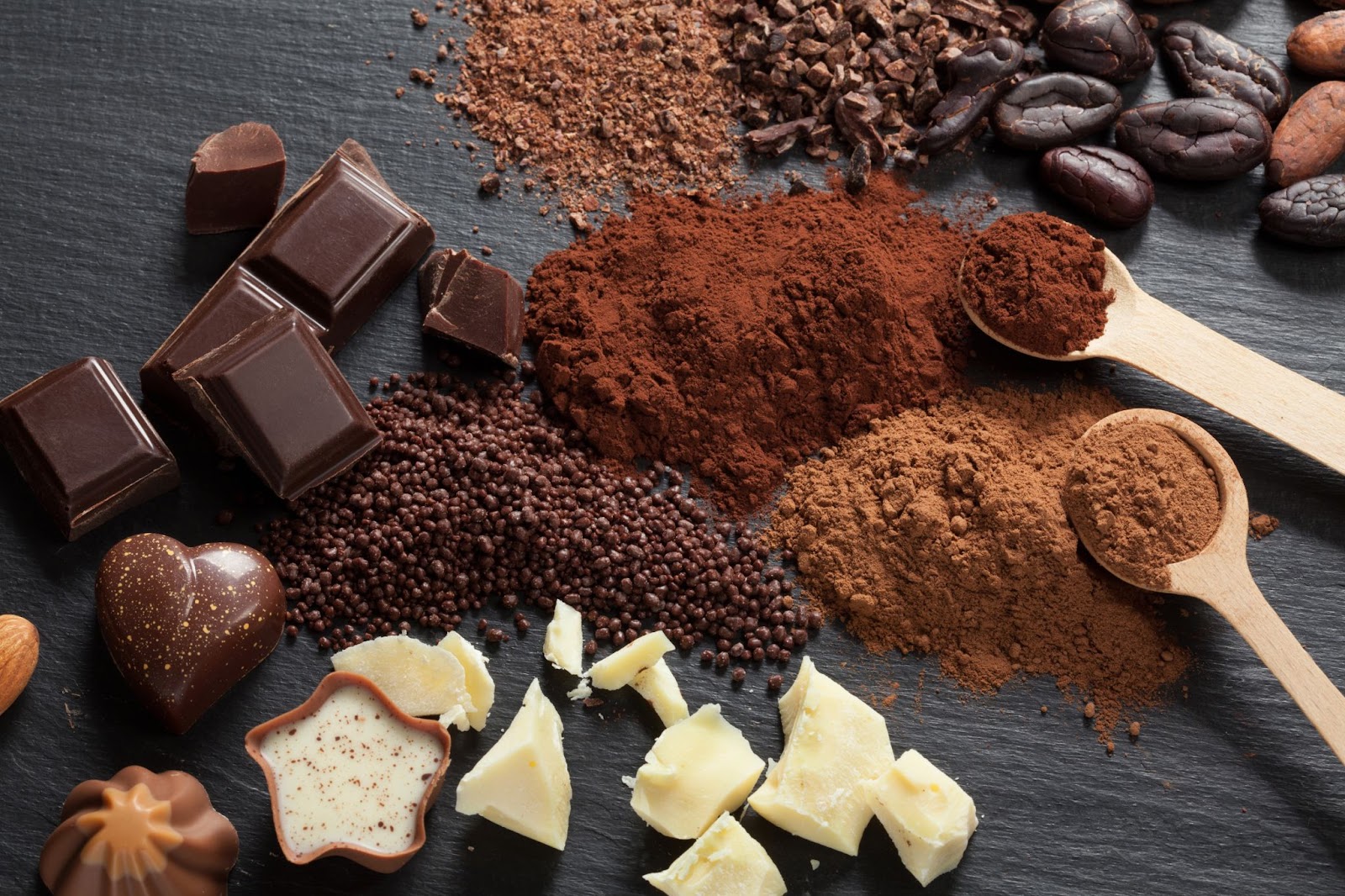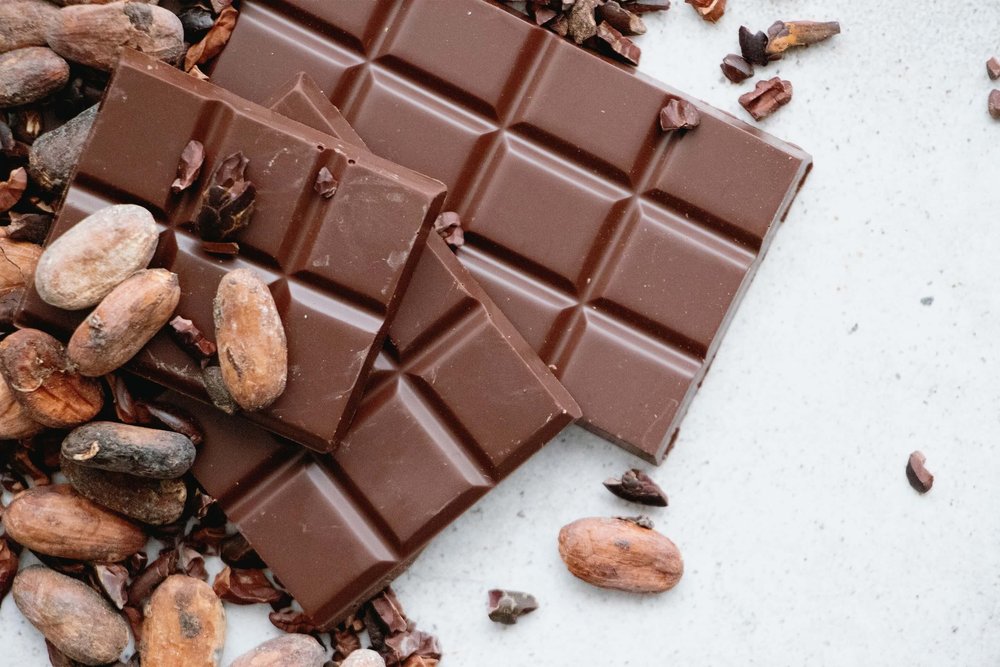The following standards apply to all chocolates:
Cocoa Powder
This unsweetened powder is pulverized, partially defatted chocolate liquor. Cocoa powder gives an intense chocolate taste and is available in “Dutch-processed” (alkalized) or natural varieties. Natural cocoa powder is light brown, with a strong, pronounced chocolate flavor. It is slightly acidic, so it is best to use natural cocoa powder in recipes calling for baking soda. Alkalized cocoa powder is darker in color, less acidic, and has a milder chocolate taste. It is recommended for recipes that call for baking powder.
Unsweetened Chocolate (100% Cacao Content)
Also known as Chocolate Liquor, Pure Chocolate, Bitter Chocolate, Baking Chocolate. This is pure chocolate liquor, composed solely of ground cocoa beans, and it does not contain alcohol, despite the name. It naturally contains about 53% cocoa butter (fat). Although it looks and smells like chocolate, it has a bitter taste and is not meant for consumption on its own. It is best used in cooking when combined with sugar to make it more palatable. Because cocoa beans contain equal amounts of cocoa butter and cocoa solids, unsweetened chocolate lends a deep, rich chocolate flavor to baked goods. It is the base ingredient in all other forms of chocolate, except white chocolate.
Dark Chocolate
Chocolate that contains chocolate liquor, sugar, cocoa butter, vanilla, and lecithin (an emulsifier). Optionally, cocoa powder can be added. There are no milk solids added to dark chocolate. The cocoa content of commercial dark chocolate bars can range from 30% (sweet dark) to 70-80% for extremely dark bars. Bittersweet chocolate and semi-sweet chocolate also fall into the “dark chocolate” category.
Bittersweet Chocolate (35-50% Cacao Content)
Chocolate, as defined by the FDA, contains at least 35% cocoa solids. Most bittersweet bars contain at least 50% chocolate liquor, with some bars pushing 70-80% chocolate liquor. This chocolate often has a deeper, more bitter flavor than sweet dark or semi-sweet bars. However, the amount of sugar in the chocolate is not regulated, so one manufacturer’s “bittersweet” chocolate may taste sweeter than another’s “semi-sweet” chocolate.
Semi-sweet Chocolate
Semi-sweet chocolate contains at least 35% cocoa solids and is generally assumed to be darker than sweet dark chocolate but sweeter than bittersweet. However, the lack of regulations regarding sugar content means that these classifications are relative and not consistent across brands.
Sweet Dark Chocolate (15-34% Cacao Content)
Sweet dark chocolate contains at least 15% unsweetened chocolate and less than 12% milk solids. Sweet dark chocolate is more commonly called Dark Chocolate, although it has a lower cacao content than Semi-sweet Chocolate. It has a high percentage of sugar and is much sweeter than other types of dark chocolate.
Milk Chocolate
In addition to containing cocoa butter and chocolate liquor, milk chocolate contains either condensed milk or dry milk solids. Optionally, cocoa powder can be added. Milk chocolate must contain at least 10% chocolate liquor (in the United States), 3.39% butterfat, and 12% milk solids. Milk chocolates are typically much sweeter than dark chocolate and have a lighter color and a less pronounced chocolate taste. Milk chocolate is more difficult to temper properly and more prone to overheating.
White Chocolate
White chocolate gets its name from the cocoa butter it contains but does not contain chocolate liquor or any other cocoa products. As a result, it has no pronounced chocolate taste but commonly tastes like vanilla or other added flavorings. By law, white chocolate must contain a minimum of 20% cocoa butter, 14% milk solids, and a maximum of 55% sugar.
Couverture
The word couverture means “to coat or cover.” Couverture is used primarily by professional bakers or confectioners. This chocolate contains a very high percentage (at least 30%) of cocoa butter, as well as a high percentage of chocolate liquor. This high ratio makes it expensive, but it also means that the resulting chocolate is smooth and melts quickly and evenly. Couverture chocolate is the preferred chocolate for tempering and enrobing candies. It comes in dark, milk, and white varieties.
Compound
Also known as Chocolate Coating, Chocolate Flavored Coating, Confectionery Coating. These terms refer to candy products that are flavored like dark, milk, or white chocolate and substitute vegetable or palm oils for cocoa butter. These chocolates are specially made for manufacturers who want to impart a chocolate feel to their products and are suitable for businesses that consider product cost. They do not contain significant amounts of chocolate liquor; thus, they do not have a strong chocolate flavor like Couverture. However, they have excellent melting and molding properties and are often used in candy making for dipping or enrobing since they do not require tempering and can withstand high ambient temperatures. Be careful never to mix candy coating with real chocolate, as the fats are not compatible, and the resulting candy will be unattractive and discolored.
Single Origin Chocolate
Also known as Single Bean Chocolate, Origin Chocolate, Estate Chocolate, Grand Cru Chocolate. Single origin chocolate is so called because the cocoa beans used to create it are taken from a single source/origin, in some instances a single estate or plantation but mostly a single country. It refers to the origination of the cocoa beans used to create the chocolate and not the finished chocolate itself. Each cocoa grown in certain regions or countries possesses very distinct characteristics due to the local weather and soil conditions. The source and use of certain cocoa allow chocolate makers to create premium quality chocolates that have particular charismatic flavor profiles.
The best approach to tasting the chocolate is in a similar fashion to tasting wine – from sensing the unique aroma of each estate to cleansing the palate in between tastings.





